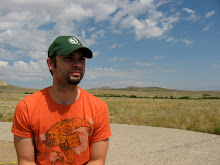 Another problem DiDio has encountered with DC fans is when he lets two mandates merge: his desire to revitalize characters by creating new identities for them and his goal to increase the number of characters who represent visible minorities.
Another problem DiDio has encountered with DC fans is when he lets two mandates merge: his desire to revitalize characters by creating new identities for them and his goal to increase the number of characters who represent visible minorities. I think that the first mandate is a necessity of publishing. I may not like it when my preferred version of Flash, Green Lantern, Firestorm, Blue Beetle, or the Question gets replaced, but I don't like it when my favorite TV shows get cancelled, either. Capitalism isn't without its drawbacks (he says as his life savings dry up).
It sucks when, say, Firestorm: the Nuclear Man doesn't sell enough

copies to warrant continued publication. But, too often, disappointment with a market that won't support a favorite character manifests as hatred for new iterations of that character. I agree that Ronnie Raymond, the original Firestorm, had a pretty nonsensical death (loss of nuclear containment due to magic sword), and so the manner in which the new Firestorm, Jason Rusch, appeared was frustrating to many fans. Those fans had a strong emotional attachment to Ronnie, and are upset that he's not around anymore. Some of those fans HATE Jason Rusch. Why? (Oh yeah...and Jason Rusch is kinda black.)

Because some people are stupid. The argument I've read a few times is that diversity in comics is "reverse racism," which should not be confused for the opposite of racism (something like, I dunno, universal compassion for the other). Racism, as we can probably all agree, is the discrimination against a person or group based on race or visual markers of difference. Reverse racism, I think, is a coded term for affirmative action - "racism," in this formulation, is limited to discrimination against visible minorities and, therefore, "reverse racism" is discrimination against white people in favor of visible minorities. The argument that Jason Rusch is the product of a "reverse racist" company suggests that DC Comics hates white people.
Really?
To be a fit fairer, the argument is rarely that explicitly distasteful. The more common line of reasoning is that it's not discriminatory to want a character who was originally white to remain so. To replace such a character with a visible minority is wrong because it is tokenism and a disservice to both the original (white) character and the (non-white) replacement.

In defense of tokenism, and DiDio's desire to broaden the racial diversity of his characters, the DCU is pretty monochromatic. At least melanin-wise. Look at the Big Seven version of the Justice League [pictured way above]: the only non-white member they have is green...and his secret identity is a white guy (they also only have one female member). Look at the Sattelite Era, which has powerfully influenced the current incarnation of the League. Fourteen members [fifteen if you count Hawkgirl, not illustrated above], and only two members aren't white. There the green guy again, and a red guy...but his secret identity is white, too (a few more girls, though, which is nice).



Now, I know that diversity isn't simply a matter of race. But only the Detroit Era of the Justice League [above] even approached a membership that could be considered anything other than middle class Americans. DC has a long history of publishing some good stuff, but they have a definite weakness when it comes to publishing super-heroes who aren't white men. I think that Dan DiDio and the DC folks should be applauded for trying to increase the diversity represented by their characters.
Sure, replacing a white male nuclear reactor with a black male nuclear reactor, or a rich white industrialist who dresses up like a bug with a lower-middle-class Latino high schooler who dresses up like a bug,


or Steve Ditko with a lesbian Latina alcoholic is the product of an overt diversity mandate. But since lower-middle-class Latino high schoolers read comics (I don't know about my other examples), why shouldn't there be at least one character for them to identify with? Or, perhaps more importantly, why shouldn't there be characters to represent otherwise unrepresented facets of the lived human experience?


No comments:
Post a Comment